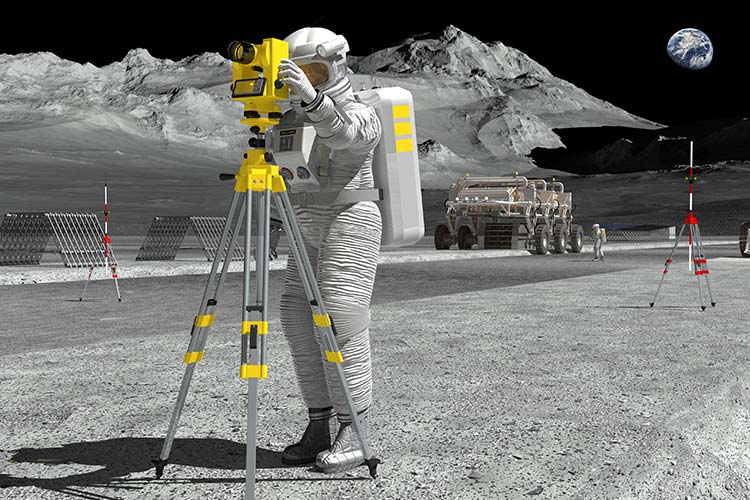A long time ago, in a small Florida town far, far away from College Station, Texas, a young Patrick Suermann marveled at the space shuttles launching from the nearby Kennedy Space Center just off the coast of the Atlantic Ocean.
Today, Suermann remains captivated by the potential for space exploration—but in a way that is somewhat unexpected.
Suermann’s interest is less rooted in figuring out how to travel back to the moon or the requirements for making the maiden human voyage to Mars. Instead, Suermann, a veteran of the United States Air Force and a civil engineer, is interested in establishing new knowledge and processes that would be needed to build in outer space.
As the head of the construction science department at Texas A&M University’s College of Architecture, Suermann is part of a number of interdisciplinary research groups studying the emerging world of space construction.
Suermann’s primary research initiative, Extraterrestrial Engineering and Construction (EXTEC), aims to figure out the potential for autonomous construction in space. He’s also a part of the Texas A&M Space Alliance (TAMSA), a larger interdisciplinary group that includes partnership initiatives with NASA.
“This is still construction,” Suermann said of the potential for building in space. “This is just like the most austere and expeditionary type of construction you could do.”
Paving new ground
Space construction wasn’t initially top of mind for Suermann when he arrived at Texas A&M in 2017. Up to that point, his expertise was primarily in Building Information Modeling (BIM), a subject he mastered when he received his Ph.D. in it from the University of Florida in 2009.
And although he loved building things as a kid, Suermann didn’t initially envision a career in construction and engineering—let alone being one of the leading figures on space construction.
After high school, Suermann decided to attend the United States Air Force Academy in Colorado Springs, Colorado, thinking he would become a pilot. But upon his arrival he discovered he was partially color blind.
So, instead of becoming a pilot, Suermann studied civil engineering, and he went on to have a more than 20-year career in the Air Force, building projects on bases in far-away places such as Greenland and Guam, the tiny island territory in the Pacific Ocean.
When Suermann’s Air Force career ended and he joined Texas A&M as an educator in 2017, his department chair told him he had to embark on some sort of seminal research in the field of construction science.
“And so, I’m thinking like, ‘OK, well, what expertise do I bring to the table?” Suermann said. “’What connections do I have?’ And I kept coming back, ‘OK, well, Air Force, government; I’ve had DARPA [Defense Advanced Research Projects Agency] grants in the past.’ And so, I settled on space construction.”
Building on the moon
The challenges with building on the moon start and end with its unique environment.
“It’s 238,000 miles away,” Suermann said. “Gravity there is one sixth of what’s on Earth. So, everything that’s based on Earth, moving on Earth is based on torque. That’s thanks to gravity. Well, there is basically no gravity on the moon. So, you’re going to have to do a lot less in a lot longer period of time on the moon.”
A bigger challenge is perhaps the nature of the equipment humans can use to build on the moon.
“Just to get a kilogram of something to the moon is $1 million per kilogram,” Suermann said. “So, you’re not going to have giant pieces of equipment, nor would that actually even be beneficial. You just have to totally reinvent every idea about how you’re going to accomplish the types of things we do in construction on Earth.”
“That’s kind of the fun part,” Suermann added. “It’s the Wild West—it’s wide open.”
Outside of these issues, Suermann said another heavy area of focus is managing the material that makes up the lunar surface. The surface is comprised of a layer of its own version of an unconsolidated rocky material called regolith. Working with the surface material is particularly thorny due to the near zero-gravity environment.
What’s more, building on the lunar surface isn’t like digging a dirt hole as a foundation of an Earth-based construction project, and different forms of regolith are spread across the lunar surface. This makes dust control with potential lunar construction a major focus.
“The ultimate hope is to be able to figure out where you’re going to land on the moon, know what’s there already, and then maximize the makeup of that material, add some more stuff to it, and then through a densification process, make it into a landing pod or roads or ways to do dust control,” Suermann said.
The real danger lies in ensuring that the surface regolith doesn’t expel upwards into the environment. “You’d probably just completely sandblast whatever you just made,” Suermann said. “And you might destroy it because it’s agglutinated. I mean, it’s like glass. I’d be like sending shards of glass everywhere.”
Bringing space building down to Earth
What does the advancement of space construction mean for contractors here on Earth?
After all, while it’s impressive to learn about the potential for building in a near-zero gravity environment and the process of managing complicated and potentially hazardous lunar regolith, most construction professionals are still mired in plenty of challenges when it comes to conventional Earth-based building.
Suermann said the biggest crossover area is likely in autonomous construction.
One of the classes he’s teaching in his current semester, for instance, is Fabrication for Construction, and the class is taught entirely with robotics.
“Right now, we have a small ABB robot,” Suermann said. “We were hoping to get more of a large–scale one that could do pallet building, masonry, drywall, things like that. Those are all the areas that already have existing movement. The culmination is going to be some additively manufactured masonry-type units.”
Learning more about autonomous construction in space can only help the advancements in the area on Earth.
“I think we can all agree that autonomous construction and humans’ brains and robots’ brawn are where construction is going in the future,” Suermann said. “And so, that’s my hope—if we can put some stones in the pond with lunar construction, it’s just going to have those ripple effects that it’ll be so much easier to do in austere construction here on Earth.”











